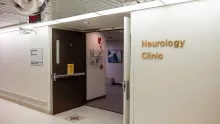Deep Brain Stimulation (DBS)
- For Neurology related requests:
- 1-319-356-2572
- For Neurosurgery related requests:
- 1-319-356-2237
The symptoms of Parkinson’s disease, other movement disorders, and epilepsy can disrupt your most basic daily activities.
But you don't have to let tremors, stiffness, slow movement, walking problems, or seizures control your life.
Deep brain stimulation (DBS) surgery implants tiny electrodes that release electrical pulses into the area of the brain causing your symptoms. It's not a cure for your condition, but DBS can improve your quality of life.
University of Iowa Health Care experts in neurology, neurosurgery, neuropsychology, and other specialties work together to determine whether DBS could be a solution for you.
Our neurosurgeons have years of experience performing DBS surgery. They're also at the forefront of research to improve and refine the procedure.
The UI Health Care approach to DBS surgery
To see whether DBS is likely to work for you, you'll have a thorough assessment by your care team. This will include evaluations of your memory and thinking, physical abilities, speech, and swallowing.
If your evaluation shows that you'd be a good candidate, your team will work with you to plan your procedure.
How DBS surgery works
During DBS surgery, your neurosurgeon places electrodes into the parts of your brain that control movement.
The electrodes deliver tiny electrical signals that block the abnormal electrical activity that causes your symptoms.
The procedure takes place in three parts:
Initial surgery to implant the electrodes in your brain
Surgery about a week later to implant a stimulator device that generates an electrical pulse. This is placed under the skin of your chest.
An office visit two to four weeks after the device is implanted to turn it on and adjust it
You may still need to take medication afterward, potentially at a smaller dose. If your symptoms worsen, your neurologist can turn up the level of stimulation provided by your device.
What to expect when you have DBS surgery
Before surgery, you'll have a set of CT or MRI scans taken so your neurosurgeon can map the precise areas where they'll place the electrodes.
On the day of your initial procedure, you'll be awake so your surgeon can make sure the electrodes are placed to control your symptoms.
- Your scalp will be numbed with local anesthetic, and a frame will be attached to your head to keep it stable.
- Your surgeon will make small openings in your skull (about the size of a dime) and place two small electrodes in your brain. The brain doesn't have pain receptors, so you won't feel this.
- You'll be asked to move your arms, legs, and hands to test the effect of the electrodes and make sure they're in the right place.
- You can expect to recover overnight in the hospital.
For your second procedure, about a week later, you'll be asleep under general anesthesia.
- Your neurosurgeon will make a small incision near your collarbone and another small incision behind your ear.
- They'll place the stimulator under the skin of your chest, then pass two wires under your skin from the stimulator up to the implanted electrodes.
- After connecting the wires to the electrodes, they'll close the incisions. This completely hides the wires and stimulator.
- You may be able to go home the same day or the next day.
About four weeks after your stimulator is implanted, you'll see your neurologist to have the stimulator programmed. This is a painless, in-office procedure.
- Your neurologist will turn the stimulator on and work with you to find the setting that improves your symptoms.
- You may need a few appointments to find the right setting.
- You'll see your neurologist two or three times a year (or sooner if your symptoms change) to have the stimulator settings adjusted.
Who can benefit from DBS?
UI Health Care experts use DBS to help people who have:
- Parkinson's disease
- Epilepsy
- Essential tremor
- Phenylketonuria
- Arm tremors related to multiple sclerosis (MS)
- Tourette syndrome
If you have Parkinson's disease, DBS may be an option if:
- You are under age 75 and in good physical health aside from your Parkinson's symptoms
- Medication helps you, but the effects wane as the day goes on
- You have significant side effects from your medications
- You don't have dementia, memory loss, or other cognitive issues
- You aren't experiencing complications of late-stage Parkinson's
Our Care Team



Want to find out whether DBS surgery is right for you?
Locations and Offices


Patient Stories
